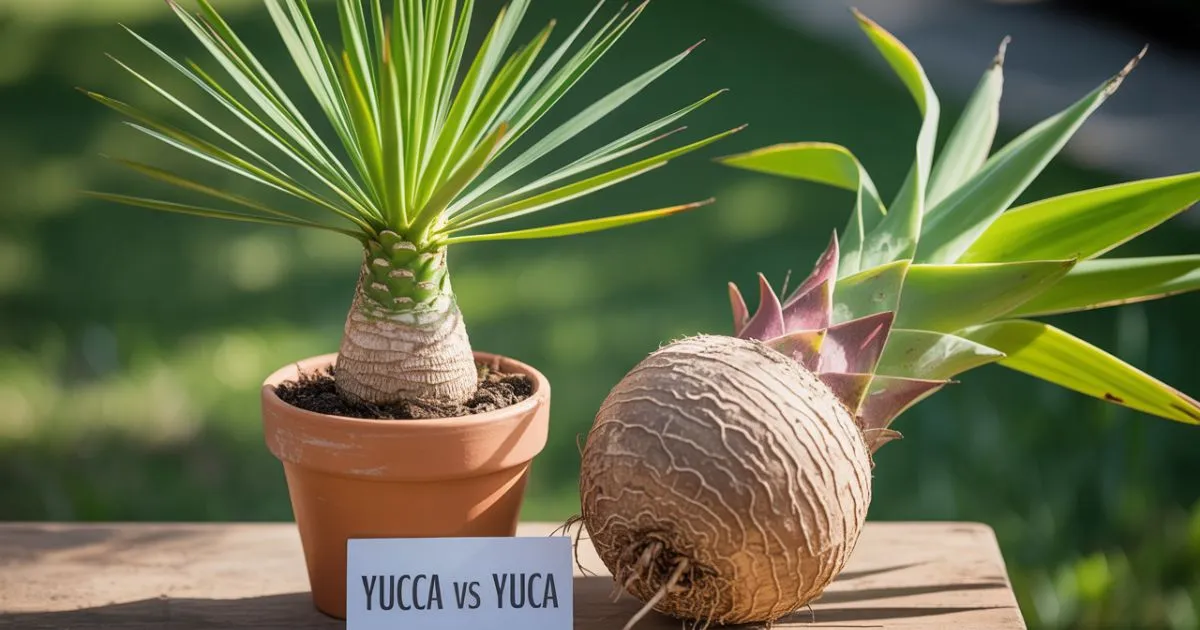Yucca and yuca are two plant names that often confuse people due to their similar spellings. However, they are entirely different in appearance, usage, and origin. While both are associated with tropical and subtropical climates, they serve distinct purposes. Knowing the difference between them can help in gardening, cooking, and nutrition planning.
Yucca is primarily a desert plant with spiky leaves and decorative appeal. On the other hand, yuca also known as cassava is a root vegetable commonly used in cooking. Both plants are valued in different ways across various cultures. Understanding their characteristics can help you make informed choices.
Botanical Differences Between Yucca and Yuca
Yucca belongs to the Asparagaceae family and is native to arid regions of the Americas. It is characterized by its sword-like leaves and tall flower spikes. Many yucca species are ornamental, often used in landscaping and xeriscaping. They thrive in dry, rocky soils and require minimal water.
Yuca, or cassava, is a member of the Euphorbiaceae family and is native to South America. It grows in tropical regions and is known for its starchy tuberous root. Unlike yucca, yuca is cultivated mainly for its edible root. It plays a major role in the diets of millions around the world.
Edibility and Culinary Uses
Yuca is a major food staple in Latin America, Africa, and Asia. The starchy root is used in many dishes, such as fried yuca, mashed cassava, or cassava chips. It is naturally gluten-free, making it a popular option for people with gluten intolerance. However, it must be cooked properly to remove toxins.
Yucca, although occasionally confused as a food source, is not widely edible. Some parts of certain species may be used in herbal teas or natural remedies. Still, most yucca plants are grown for ornamental purposes. Eating the wrong parts of a yucca plant could lead to stomach discomfort or worse.
Nutritional Value Comparison
Yuca is a carbohydrate-rich root that provides a substantial amount of energy. It contains fiber, vitamin C, potassium, and small amounts of protein. Yuca is also used to make tapioca, which is found in many gluten-free foods. Its starchy composition makes it an excellent energy booster.
Yucca, in contrast, is not consumed for its nutritional value. While some indigenous cultures use parts of the plant for medicine, it’s not a common food. Yucca supplements may contain saponins believed to support joint and digestive health. Still, its nutritional role is minimal compared to yuca.
Growing Conditions and Cultivation
Yucca plants are drought-resistant and thrive in well-drained, sandy soils. They require full sunlight and minimal care, making them perfect for xeriscaping. Yuccas are often used in landscaping for their unique appearance and low maintenance. They are common in deserts and southwestern U.S. gardens.
Yuca, on the other hand, requires warm, tropical climates and moist, fertile soil. It is grown as a crop in regions like Brazil, Nigeria, and Thailand. The roots are harvested after 8-12 months of growth. Unlike yucca, yuca needs regular watering and more care to ensure a healthy yield.
Cultural Significance and Uses
Yuca has deep cultural roots in Latin American, African, and Asian cuisines. It is often served during festivals and family gatherings in various traditional dishes. Cassava flour, made from dried yuca, is essential in many gluten-free recipes. It’s even used in bread, cakes, and tortillas.
Yucca also has cultural significance but mostly in decorative and ceremonial roles. Native American tribes used yucca fibers to make ropes, mats, and baskets. Its roots were sometimes used as soap due to their lathering ability. Today, it remains a symbolic plant in southwestern U.S. decor.
Common Misconceptions and Confusion
The similar spelling of “yucca” and “yuca” leads to frequent misunderstandings. Many assume they are the same plant or interchangeable terms, especially in food blogs. In reality, mistaking one for the other can result in buying the wrong plant or using inedible parts. This can be risky and misleading.
Another confusion arises from pronunciation. Both are often pronounced “yoo-ka,” which further blurs the lines. Clarifying the spelling and intended use is important in gardening stores and grocery markets. Education is key to preventing mistakes in both culinary and agricultural contexts.
Read More: Cane Yucca Plant
Conclusion
In conclusion, while yucca and yuca may sound and look similar, they are entirely different in purpose, appearance, and usage. Yucca is a hardy, ornamental plant ideal for landscaping, while yuca is a starchy root vegetable essential in many global cuisines. Understanding their botanical, nutritional, and cultural differences can prevent confusion and ensure proper use.
Whether you’re designing a garden or preparing a traditional dish, choosing the right plant matters. Always remember: yucca is for decoration, yuca is for dining. Clear knowledge of each ensures safety, enhances appreciation, and helps you make informed, practical choices in both kitchen and garden.
FAQ’s
What is the main difference between yucca and yuca?
Yucca is a decorative plant, while yuca is an edible root vegetable.
Can you eat yucca like you eat yuca?
No, most parts of the yucca plant are not edible and can be toxic if consumed.
Is yuca the same as cassava?
Yes, yuca is another name for cassava, a starchy root used in cooking.
Are yucca and yuca related botanically?
No, they belong to completely different plant families and climates.
Why are yucca and yuca often confused?
Their similar spelling and pronunciation cause frequent mix-ups.









